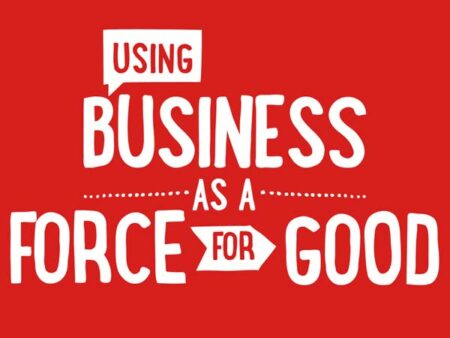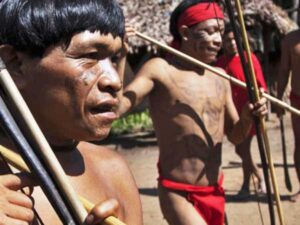B Lab manages the standards and certification process for B corps, meaning companies that have committed to principles of stakeholder governance. The definition of stakeholders is wide, including the environment, the workers, the communities where businesses are located, and more.
Andrew Kassoy of B Lab spoke with Lissa Harris on September 21, 2023. Click here to read the full conversation with insights highlighted.
Lissa Harris: To start, can you introduce yourself and your organization and describe a little bit about the problem that you’re addressing and how you’re responding to it?
Andrew Kassoy: I’m Andrew Kassoy. I’m one of the co-founders of B Lab, which is the nonprofit organization behind the B Corp movement. The problem that we’re trying to solve is, in some ways, the same problem we were trying to solve when we started B Lab in 2007. And that is the idea that business, at least as it’s practiced today, is one of the most powerful forces in society, but it’s practiced in a way that creates an incredible number of challenges for society instead of fulfilling its promise, which we think is to create a shared and durable prosperity for all. We started B Lab, and we wouldn’t have used this language at the time, but we started B Lab to drive systems change. As opposed to trying to change the behavior of individual businesses, we wanted to change the way the economic system works so that it is inclusive, equitable, and regenerative.
The way we think about doing that is really three things. One, we need to change the behavior of business because business, in the end, is the big economic driver in our society. It creates jobs. It creates products. It is the one that creates a lot of environmental damage. It can deplete communities and it can create a lot of low wage jobs that don’t have a lot of dignity. We want to change the behavior of business so that it actually creates great jobs that build wealth and so that it restores communities and regenerates the environment.
To do that, there are some things that need to be changed about the system. One is that we needed to change the narrative about the purpose of business in the first place so that people come to have an expectation that business doesn’t exist to create profits only for investors, but actually to create value for society. Secondly, it’s nice to change the narrative, but if the rules of the game are contrary to that idea, then you won’t change the system. And so the second big thing is really trying to change the rules of the game, like changing the actual laws by which businesses practice so that we no longer have a set of rules that say that the purpose of business is to maximize profits for shareholders, but instead [the purpose of business is] to maximize value for society.
Lissa Harris: Who are the people that you’re serving or the organizations that you’re serving directly? Who benefits from your work and how specifically do they benefit?
Andrew Kassoy: The most direct, I wouldn’t say beneficiary, but the most direct actor that we work with, or work through, is businesses. Business is not like a human being or the environment. Businesses are just entities. Fundamentally, the beneficiaries are meant to be the stakeholders of business. And so whether that’s workers or communities or the climate or biodiversity or more broadly society, those are the stakeholders of business who we want to benefit from the work that we’re doing. We see business as the primary actor that affects all of those stakeholders.
Lissa Harris: Are you mostly working with businesses that are forming? Or are you working with businesses that are converting to B Corp status?
Andrew Kassoy: It’s a huge range. B Corp is a certification, and it’s meant to be a certification for good businesses. The certification has quite a high bar. There are basically two things that a company needs to do to get certified as a B corporation. One is they need to meet a set of social and environmental performance standards. And so we’ve created a bar. A lot of people talk about ESG [Environmental, Social, and Governance], and that’s primarily about reporting standards. This is a performance standard, and so you actually have to meet a minimum bar for performance on your social and environmental impact through your business. So by definition, that means companies that are already in business that are already having a positive impact because that’s what it takes to actually get certified in the first place.
The second part of the certification, which we think is absolutely critical, and it gets to some of the systems change work, is that businesses, to get certified as B corporations, also have to change their governance so that their fiduciary duties have been expanded. They’re no longer just accountable to create or maximize value for their shareholders. They actually have a legal responsibility to create value for their stakeholders. And that’s a fundamental shift in how a business is run.
Companies have to do both of those things, actually meet performance standards and then meet this legal test in order to get certified as B corporations. So those companies range from relatively early stage businesses that are trying to bake this into their DNA from the start to companies that are much further along and have had to go through a real journey in order to get certified, because often legacy businesses, particularly big ones, weren’t built like this. They were built in a different era where the only thing that they were told to think about was maximizing value for their shareholders. And so those kinds of companies have had to go through a real journey to get from where they were to a place where they can meet those performance standards and get certified as B corporations.
And there was real intention behind that idea. We thought if you want to try to change the economic system, one thing you need to do is have a lot of advocates for changing the system. In other words, you need to build a movement that has a lot of marchers. And in this case, our marchers are businesses because we thought that they actually would be very powerful advocates for change, whether it’s changing the narrative about the purpose of business or trying to change the laws, that by building a huge movement made up of businesses that we could aggregate their collective power to change the game.
But those businesses, therefore, have to be credible. People have to actually be able to look at them and say like, “Oh yeah, I understand. They really are doing something different.” And so when they’re speaking with a collective voice, it’s got credibility. That’s why we started with a certification for those businesses that has a relatively high bar. We wanted to build that credible movement.
Lissa Harris: What makes your approach distinctive from other organizations that are working in a similar space?
Andrew Kassoy: I think the special sauce is that movement building element. There are lots of organizations whose shoulders, essentially, we stand on. There are lots of people who’ve been working on standards for social and environmental impact for a very long time. There are business organizations that have been working on those issues, often by issue area or by industry. So in forestry, you have a certification for responsible stewardship of forests and in food you have organic and you have fair trade. Each of those things is either like a product or an industry or a stakeholder focused kind of standard or certification.
What we’ve tried to do is create a certification that is more broad and it looks at the whole business. There isn’t anything else out there that really looks at the whole company as opposed to its product or its impact on one stakeholder.
I’d say the second thing is the idea of changing fiduciary duty. There’s no one else that really works on that in quite the same way. And we think that’s the fundamental systems change that you really have to drive. We try to work with a lot of other organizations that have this kind of common idea about changing the narrative about the purpose of business. But I think, today, we’re the only ones that try to back that up with this credible community instead of by driving an idea.
Lissa Harris: Is there an example you can share that illustrates the impact of the work that you do?
Andrew Kassoy: Well, there’s lots of examples at the company level – of companies changing their practices. By going through this process of becoming certified and then being part of this community, they sort of upped their game. So companies that have recognized that they thought that they were great for their employees, but then they realized that actually down through their supply chain, they had lots of outsourced things that they did where people weren’t earning a living wage. And so it wasn’t just that they needed to change their own practices, but they needed to change the way what they demanded of companies in their supply chain, for example, or companies that thought that they were doing a really good job on the environment but didn’t actually have a plan in place to be net zero on climate emissions by 2030, not just from their own operations, but again all the way down through scope three.
There’s a lot of positive peer pressure on companies on their behavior. So I’d say that’s one whole area where there’s been dramatic shifts is companies and their impact on their individual stakeholders, but that doesn’t change a whole system. The places that I would probably point out that I think are even more impactful are the places where those companies are acting together to create change.
For example, there are now about 42 jurisdictions in the US, 42 states and over 10 countries outside of the US, that have actually changed their corporate laws to enable companies to become what are called benefit corporations. It’s like a new legal distinction under corporate law for companies that want to have a broader set of fiduciary duties. And the way those laws have been passed is that B Corps have worked together to approach legislators in their states or outside of the US and their countries to actually change those laws. So the power of the collective to then advocate for policy change has really been powerful.
Lissa Harris: Is there a particular company’s journey that stands out to you?
Andrew Kassoy: That’s a good question. There are so many. There’s 7,500 certified B corporations, and so there’s 7,500 great stories. I think just to give you a sense of the range of those stories, on one hand you have companies like Patagonia that have been built like this from the start, and so they didn’t need a B Corp certification to prove to everyone that they are a responsible company that’s constantly pushing the edge of the envelope. But they’ve said over and over again that they needed B Corp to help tell that story and to make it credible, and actually that they needed the legal structure that we created, the Benefit Corporation, in order to make some really big fundamental changes to their business, like the one that they did last year where they transferred ownership of the company from the founders, the Chouinard family, to a trust, what’s called a purpose trust, that governs Patagonia, which is a benefit corporation and a certified B Corp. That’s now created a model for a totally different way to sell a business. They’ve basically sold it to the planet and it now has one stakeholder, which is the planet.
At the other end of the spectrum, not uncontroversially, there’s a company like Nespresso, which is a big global brand that spent four years going through the process of trying to get certified as a B corporation and had to make a lot of changes, everything from how it deals with coffee farmers all over the world to its own employees to some of its environmental practices, to a bunch of its governance practices in different markets to how it dealt with its business in Russia at the time of the invasion of Ukraine, significant changes it had to go through in order to get certified. And as I said, there’s over 7,000 other stories like that, but that kind of gives you a sense of the bookends at some level of a business that was built to do this in the first place to a business that wasn’t built to do this, but actually has had to make significant changes on a journey in order to get certified.
Lissa Harris: Does that legal structure and having the expanded fiduciary duties have a real legal status, does that help kind of shield businesses from complaints or even lawsuits from their own shareholders?
Andrew Kassoy: Yeah, I mean, part of the idea, the reason for doing that, is that it protects the business and the intent of the business to consider its stakeholders. And so I think it does two things. On one hand, it protects management and the board and their ability to have a broader set of considerations because it’s much harder for a shareholder to sue them and say, “You didn’t do everything you could. You raised wages for your low paid workers to a living wage and we’re going to sue you because that stopped you from maximizing profits.”
And so on one hand, it creates some protection. On the other hand, it creates accountability because let’s say there’s a shareholder, a significant shareholder, who invested in the company because of their commitment to steward the environment and take care of their workers. If they see that the company is failing to do that and is actually just trying to use that as window dressing or greenwashing, while it in fact just does things to maximize profits, those shareholders could actually sue the company and try to hold it accountable for its commitments to its stakeholders. The Benefit Corporation law was written, I think, in a really creative way to balance that protection for the team, for the management team and the board, to focus on stakeholders and actually hold them accountable for doing it so that they can’t just be engaged in greenwashing.
Lissa Harris: What insights or teachable lessons do you think could be taken from your work that others might be able to put into practice?
Andrew Kassoy: There’s about a thousand mistakes that we’ve made along the way. So one thing I would say is that we thought, when we started, that we were going to build a very sustainable business model for doing this, that companies would pay a lot for certification, and that would allow us to not have to rely on philanthropy. And I think we made the mistake, at the beginning, it was just a lack of imagination, but thinking that what mattered was primarily creating a sustainable business model, that we were going to do it differently than other nonprofits.
One of the really important things as a nonprofit is to be clear from the beginning about what you’re trying to achieve. And we should have realized that we weren’t trying to just build a certification that generated a lot of revenue. We were, in fact, trying to build a movement. And movement building is really hard, especially movement building that’s focused on systemic change. It requires sustained philanthropic support because there’s not really a business model for movement building.
I think it’s really important for people to think about that and not just what’s going to get us through a year or two, but what’s the sustained model for five or 10 or 15 years that it takes to even start to make a dent in changing a system, especially one as powerful as the capitalist system that we’ve got today. So that’s been one big learning, and we’ve really had to shift how we thought about what’s legitimately got a sustainable business model and what really requires philanthropy, and then how do you partner with philanthropists to start to really think about systems change and what it takes to change a system, not just what it takes to do more direct service work.
Lissa Harris: I was going to ask if that was a tension, that you yourself are not a B Corp?
Andrew Kassoy: Well, we’re a nonprofit, and it’s a great question. We had a decision early on to make about that, and we thought about being a B Corp ourselves. The three founders of B Lab, we were all coming from the private sector, so we didn’t have social justice or nonprofit kind of credibility. And when we thought about it, we thought if we are any kind of a business, not a nonprofit, that people will always sort of be like, “What are they really up to here,” or, “What’s their real objective?” So we decided very early on to just be clear like this organization is a nonprofit. There’s nothing in it for anybody other than the mission. And we should have realized, then, that in making that decision, that meant that we were always going to need philanthropy and we were always going to have to educate and cultivate donors to understand what this mission was all about because it’s not traditional philanthropy.
Lissa Harris: How do you measure success? What’s the evidence that you’re making progress?
Andrew Kassoy: Great question. And I think this is one of the hardest things for any organization that thinks they’re involved in systems change. By definition, changing a system is a super long-term effort and it’s hard to know when you’ve succeeded. And so what we’ve had to do was create mileposts along the way that give us indications. And some of those are anecdotal. Some of them are quantitative, [some of them] are about how many B Corps and how quickly is the movement growing? Is there evidence that it’s doing this instead of just sort of a straight upward line? Those things are true, but we also try to look at things like how many laws have we been able to change?
We also look at a lot of measures of community engagement around each of the things that we’re working on. How many companies have actually changed their practices, what kinds of impacts the companies themselves are having, how many acts of collective action are there? We have over a thousand companies that have committed themselves to be net zero by 2030, as an example, and that’s coming from them working together. And then we look at how many other companies are they influencing? So it’s not just a question of how many B Corps have done that, but have they influenced thousands of other companies? An example of that that we look at really carefully is, while there are 7,500 certified B corporations, we now have over 200,000 companies that use the B impact assessment, which is the set of performance standards that you need to meet to become a B Corp.
We have 200,000 companies that use those performance standards now for their own purposes, like for internal assessment purposes. And the bigger that ratio grows of total companies using it to certified companies, we actually think is a really important mark of how much influence those 7,500 certified B corporations are having on the rest of the universe of companies to change their practices.
Same thing with the legal structure. There are now about 15,000 companies other than B Corp that have adopted that legal structure. We look at how many of those companies are in the public markets. There are over 50 companies now that are publicly traded, and we look at the growth of that as a measure of how much influence we’re starting to have over more mainstream capital markets. There’s a range of things like that, that we try to look at that are both very quantitative and that are then are more about movement building to try to get some sense of are we moving in the right direction.
Lissa Harris: You talked about this a little bit when we were discussing your thoughts and thinking that what you wanted to do was to develop a sustainable business model and then moving away from that. But I wonder if you could talk about things that you’ve tried that didn’t work, that you learned an important lesson from. Is there another example of that that you want to share?
Andrew Kassoy: I think another important lesson, this is a little more about organization building than it is about the outside facing movement building, but I think it’s important for social entrepreneurs to think about, is what got us here isn’t going to get us where we want to go. You have to be constantly open to change in how you do your work, even if you’re fixed in your vision of what you’re trying to achieve, because it changes. The way to achieve it over time changes dramatically.
For example, we set up our organization when we started with a model that built independent partners in each region of the world who would build a community of B Corps in their market. So we kept standards and the certifications centralized, but we created partnership organizations that were going to build the B Corp movement in each of their regions of the world so that it would feel authentic in each market and could adjust the context of each region of the world.
We knew, in order to do that, that we needed to leave as much revenue as possible in those markets in order to make sure that they could build their community. And so most of the certification fees that we charged went to each local partner, while we at the center relied on philanthropy to support us. What’s happened over time is that some of those partner organizations have become quite successful because they keep most of that revenue, but at scale now they have a lot of revenue, but B Lab, the mothership, has had to also scale to meet the demand of all that growth. It’s a different thing to try to raise $7 million of philanthropy than a million dollars of philanthropy, so the economic model no longer works. The center is kind of being starved because by intention, we set it up so that each of the partners in the network would have a lot of revenue in order to build their organizations.
So that doesn’t work anymore, and it’s actually become counterproductive for scale, but that means now we need to go back and renegotiate those relationships with partners who’ve gotten used to that relationship. That’s a very difficult challenge to start to rebalance both financial and power relationships, but a necessary one for the overall purpose of the movement.
And what we didn’t do when we created those relationships was we didn’t sufficiently think through the fact that that was going to need to transition over time. And so instead, now we have to face that without having said to everybody in the first place like, “Oh, this isn’t how it’s always going to be. This is how it is for now.”
And so one piece of advice I just have for all social entrepreneurs is to just think about the fact that everything is transitional. Everything you do is transitional because the problem you’re probably trying to solve is not a short-term, clear fix, so the means you use to reach that end are going to have to shift over time, and you have to have the flexibility to pivot.
Lissa Harris: This leads very nicely into the next question, which is about challenges that you face that you haven’t yet been able to overcome, whether that’s scalability, like you’re talking about, or opposition to your goals, or accessibility. We know the main challenge for everyone is funding, so setting that aside, what are the other challenges that you’re facing from the context that you’re operating in?
Andrew Kassoy: One big challenge for the B Corp movement is how to think about scale. And I think one of the things that we’ve learned is scale does not just mean how many certified B Corps are there. We’ve been clear on that for a while. What we haven’t figured out is how a movement that was built on the credibility of people who are meeting a very high bar, how does it engage with or bring to it more mainstream business? Not everyone’s going to be a certified B Corp. How do you deal with all of the people who want to make incremental change? While we have, as I said, hundreds of thousands of companies using this impact assessment, it’s not clear enough that they are changing their own behavior. It’s not clear that that is adding to the power of a movement.
We haven’t quite figured it out yet. Do you create some other product that is associated with the B Corp, but that doesn’t detract from the integrity of it? There are some real questions about scalability. We know we need scale if we’re going to have a movement that has power, but we have to figure out how to do that in a way that maintains the credibility of the brand. Otherwise, we lose the integrity of the movement and then the power anyway. That’s one big challenge that we still face. There’s lots of others, but that’s probably one of the biggest ones.
Lissa Harris: You’ve talked a lot in this interview about how you’re working to advance systems level change in this field. Is there anything else specific that you wanted to say about that?
Andrew Kassoy: Well, I think one interesting thing, I think people see this in lots of places, but for a long time we’ve been talking about this and we’ve gotten nothing but love for it. I think one of the reasons for that is it wasn’t big enough to be a threat. One of the big things about systems change is, for a while, you just get dismissed because no one understands it. Then you start to get some traction and people think it’s really cool and inspiring, but they also mostly pat you on the head because it’s cute, but it’s kind of a side show to the big game. Then you get to a point, which is where I think we are now, but also it’s not just us. There’s a broader movement focused on this idea of stakeholder capitalism or sustainable capitalism. You get to a point where all of a sudden now it’s like a threat because it actually has some real traction and some scale, and then there’s a backlash, then there’s real pushback.
One of the biggest challenges we face today is this anti-ESG [Environmental, Social, and Governance] backlash, which is very political, but I think it’s beyond just political. It’s threatening to the way a lot of people practice business and to the way a lot of people make money. And so as it’s becoming powerful, then people are threatened by it and they push back hard. That’s one of the biggest challenges in front of us, is not just scaling a movement, but preventing regression.
Lissa Harris: In speaking of the anti-ESG movement, it is an obstacle for you, but I feel like you’re kind of presenting it or seeing it as almost a marker of success that you’ve gotten so far that there’s this pushback. And it’s kind of heartening to hear because I talked to some other folks who are discouraged by what they see as backsliding in this realm.
Andrew Kassoy: Yeah, I mean, I am discouraged by the political environment that we face. And so yes, and particularly on climate, I’m discouraged that people just don’t act with the urgency that I think we need. But I also see the pushback on what we’re doing, or the backlash, as a sign of success. And I think largely, as social entrepreneurs in our movement, we’ve been inspired by it. Like, “Hey, if people are really pushing back hard, that means we must be doing something. This must be worth it.”
And so in some ways it’s energizing us, and I think that’s really important. This kind of work can often be a slog, and there’s plenty of elements of it that are discouraging, including all the stuff about how hard it is to get resources to do the work. And so sometimes you need the cheerleading. Sometimes the pushback actually is the thing that’s the most energizing. Right now I think that’s helping us circle the wagons. It’s helping us all see, “Hey, what we’re doing really matters, and we need to double down.” We need to double down on both care and courage in this work.
Lissa Harris: What do you think is most needed from other actors or partners or government, whatever other entities, to advance systems level change?
Andrew Kassoy: Well, government, we need a functioning government. On one hand you can say, “We’re so frustrated the government doesn’t function.” Or you can say, “One of our big roles is to demand that the government functions.” When I think about what needs to be different in the next 10 years than the last, I think our movement has to be way more engaged in the public policy realm and getting business leaders to demand that their policymakers behave differently. I think that’s a huge part of the game here. And it’s not just here, it’s in other markets around the world, other major markets.
I think we need philanthropists to think more systemically and be a little less focused on what your results are going to be from this grant by six months from now. They need to think more like, “how can we partner with you to be a partner and a part of this movement for the next five years?” We’ve been very lucky. We have a few funders, like Skoll, like the Ford Foundation, that have been working with us for 10 years at this point, and that’s made a dramatic difference to have that kind of commitment.
So that’s government and philanthropists. I think we need to figure out consumers. We have all these businesses, and one of the most powerful places that we’ve been able to work is those businesses working with their supply chains and with their workers, which is built like a broader movement. I think we’ve been less successful so far in translating the power of that brand into more of a citizen movement through the consumers of those 7,500 companies, because there’s obviously hundreds of millions of consumers who pay attention to all those companies, and we haven’t figured out how to make those consumers powerful advocates for systems change.
Lissa Harris: How do you see your work evolving over the next five years?
Andrew Kassoy: Well, as I said, I think public policy is one of the most important areas. But more broadly, I think our work with the businesses on collective action is a critical area where we see them not just as individual certified B corporations, but as a community who can exercise far more power through collective action. And so whether that’s getting them to take collective action on climate by acting together and trying to get other businesses to make really big climate commitments, or whether it’s on racial equity to get those businesses to be far stronger advocates for different behavior by business around racial equity, or whether it’s working with labor to drive different behavior and different practices to create higher quality jobs, any of those kinds of things, I think, are the places where we’re going to have to do much more than we’ve done in the past.
Lissa Harris: I want to thank you so much for your time and your insight.
Click here to read the full conversation with insights highlighted.
Lissa Harris is a freelance reporter and science writer (MIT ’08) based in the Catskills of upstate New York. She currently writes about climate, energy, and environment issues from a local perspective for the Albany Times Union, her own Substack newsletter, and various other digital and print publications.
* This interview has been edited and condensed.
Read more insights from what’s working in social innovation.







